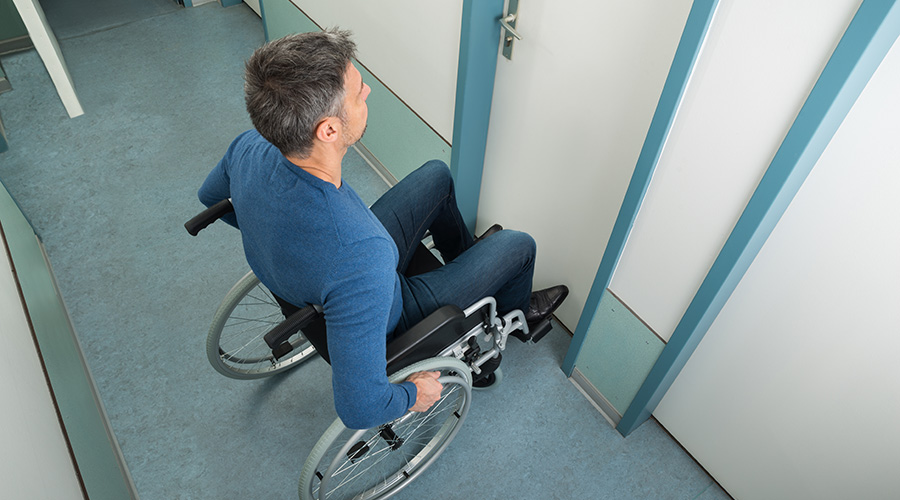Access, Texas Style
Maintenance plays a central role in the Texas-sized task of ensuring access to San Antonio’s municipal buildings
The task of ensuring accessibility to facilities and properties in any metropolitan area is complex, to say the least. Old buildings present unique and often costly challenges, and despite the best of intentions, new buildings aren’t always fully compliant with federal, state and local guidelines. Also, building occupants and operations move continually, creating additional work to ensure that new work areas are accessible.
Now, take that challenge and apply it to San Antonio, the nation’s ninth largest city, which has about 900 municipal facilities and properties with a total of about 11 million square feet. The effort required to provide access and ensure comfort can seem overwhelming.
San Antonio municipal officials knew that addressing accessibility issues would require a coordinated effort among a range of agencies and departments, says Judy Babbitt, planning manager for the city’s disability access office. She adds that the building maintenance department emerged as both the team that would carry out much of the repair work in facilities and an invaluable resource in the planning and design phases.
“Maintenance has become a very good advisor to architects,” Babbitt says. “They think about efficiency and effectiveness. They are the best resources in town for door operators. They have become the best resources for anything they are working on.”
Taking Stock of Access
As is the case with most organizations, San Antonio’s efforts to make its municipal facilities comply with access guidelines did not start with the enactment of the Americans With Disabilities Act in 1992. Both federal and state guidelines in place prior to ADA’s arrival had given city officials guidance in making facilities accessible.
Still, city officials knew they needed a better handle on the status of access in San Antonio. Aware that a number of municipal facilities presented both occupants and visitors with barriers to access, the city undertook a survey in 1992 to assess the state of issues such as compliance and access guidelines relating to issues such as building access and restroom accommodations.
“There was a general awareness of how inaccessible we really were,” Babbitt says. The survey turned up few surprises.
“We found that there was an awful lot of work to do,” Babbitt says. “This is an old city with a lot of old buildings.”
Working from survey results, the city put together a plan consisting of more than 400 projects designed to upgrade city facilities. Then, in 1999, the U.S. Department of Justice (DOJ) selected a number of cities for inspections to determine the level of compliance with ADA, and San Antonio was among those cities.
Working with DOJ inspectors “was easy because we were prepared,” Babbitt says. The inspectors focused on the city’s Riverwalk, as well as on small municipal parks and police substations, Babbitt says. Inspectors found access problems in 27 municipal buildings and directed the city to make 240 corrections, many relating to such items as the placement of signs, the height of grab bars and the location of coat hooks.
The city signed a draft settlement with the DOJ and agreed to comply within three years. The city added the DOJ’s findings to its original list of projects.
“So far, we’ve spent about $11 million making our facilities acceptable and accessible,” says Bill Washkoske, building maintenance manager in the city’s public works department. That dollar amount covers 184 projects that includes both individual projects designed to address access barriers and building renovations that include work to improve access.
Rethinking Repairs
In some cases, the solution to access issues required a rethinking of the approach to repairs, not necessarily a change to the physical space. And in some cases, these solutions were appealing because they were relatively low cost and easy to achieve, Washkoske says.
One example of such a project involved restroom flush valves. In some restrooms, flush valves had been installed on commodes on the narrow side of the stall, making them inaccessible for some users.
Reconfiguring the plumbing to relocate the flush valve would have been relatively costly and time-consuming. The answer was to install fully automatic flush valves with sensors on the commodes, eliminating the need for manual flushing.
“Right away, you make them compliant, and it wasn’t too expensive,” Washkoske says. In municipal government, as in many institutional and commercial settings, cost is among the top concerns when it comes to planning repairs and renovations to enhance access.
“It’s scary to see that the cost of one ramp can be as high as $200,000,” Babbitt says.
Another example of a relatively low-cost repair that addressed accessibility involves restroom mirrors. To ensure that people using wheelchairs can see themselves the mirrors, guidelines mandate that the bottom of mirrors be no higher than 42 inches above the floor.
Washkoske says the challenge in non-compliant restrooms is that making the mirrors accessible often is expensive because it requires reconfiguring countertops and plumbing and lowering the mirrors.
The answer in this case is mirrors that are tilted down, a solution that enables facilities to keep the mirrors at the existing height, eliminating costs for reconfiguring existing restroom components, and enables users in wheelchairs to use the mirrors.
In many cases, product manufacturers gave city officials guidance and insights in developing and implementing repairs and renovations.
“Many vendors understand that their role is more important than just installing products,” Washkoske says. “They also provide information. Many times, just talking with vendors helps us see solutions we might not have seen because they have experience from working in other facilities.”
The Role of Maintenance
The ongoing process of upgrading San Antonio’s facilities and properties to ensure greater access has shaped the way managers and workers in the building maintenance department carry out their mission. As a result, workers are taking a closer look at even routine repairs and modifications to ensure the results improve accessibility and enhance comfort.
“When carpenters are modifying a space, they take a close look at the doors,” he says. “The review locksets, and the check the location of the handles in relation to the wall.
“We’ve taught people how to deal with these issues, and now it’s part of their jobs.”
The effort to ensure access also includes updating the inventory of spare parts and equipment as a way of ensuring that workers can easily get ADA-compliant door hardware and plumbing-system components without having to make a special request that might delay the project or increase its cost, Washkoske says.
“Everybody has learned to do these kinds of things as part of any job so we don’t have to go back and make changes later,” he says.
As a result of changing the way the department approaches projects, managers and front-line workers have become valuable resources for others involved in access issues. And the department is enjoying an enhanced image, both with those inside the organization and those outside, including contractors.
“Maintenance knows the vocabulary, and they know the contracts,” Babbitt says.
Before working closely with the department, she says, “most people felt like they were just the janitors,” adding that more people in municipal government now have a better understanding of the role that maintenance plays, both in providing access to facilities and in keeping those them operating efficiently.
Related Topics:











